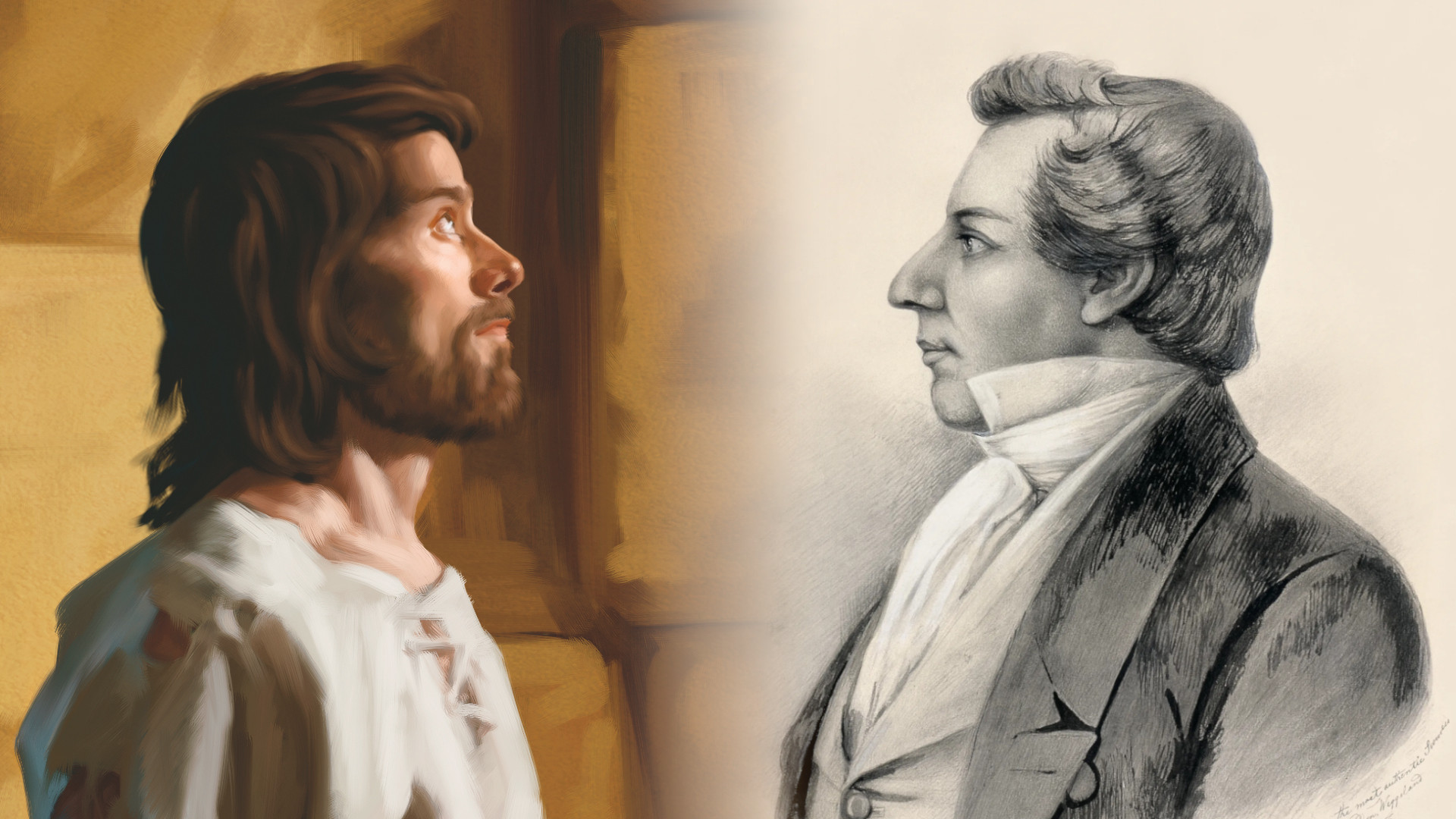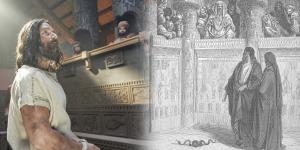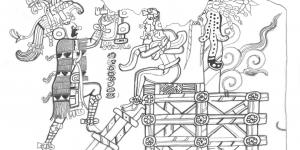You are here
How Does Nephi Connect the Name Joseph to Prophecies of the Latter Days?

2 Nephi 27:30
The Know
An earlier KnoWhy reviewed how Nephi used three particular Isaiah quotes (one being modified) to discuss God’s work in the last days, all of which included the Hebrew root yāsap.1 This is the root the name Joseph comes from.2 It is a verb with a broad semantic range, meaning to “add to,” do “again,” do “more,” “proceed to,” or “increase.”3 Nephi combines two of those Isaiah passages together, then connects them to promises made to the ancient Joseph and fulfilled through a modern Joseph:
And the Lord will set his hand again [Heb. yôsîp] the second time to restore his people from their lost and fallen state. Wherefore, he will proceed [Heb. yôsīp] to do a marvelous work and a wonder among the children of men. … Wherefore, for this cause hath the Lord God promised unto me that these things which I write shall be kept and preserved … that the promise may be fulfilled unto Joseph [Heb. yôsēp], that his seed should never perish.4
After a close reading of 2 Nephi 25–30, biblical scholar Matthew L. Bowen has found a number of other examples in which Nephi seems to be using the Hebrew root yāsap, which he proposes have thematic significance.5 In these chapters, Nephi quotes and adapts words found in Isaiah 29 to discuss the coming forth of the Book of Mormon through an unlearned man Nephi may have known would be named Joseph.6 Words potentially derived from yāsap are also used when Nephi deals with additional revelation generally, the coming forth of the Book of Mormon specifically, and the blessings that the Restoration will bring.
Receiving Additional Revelation
Nephi teaches much about the reception of revelation and the proper way to add more to that which is already had. Nephi describes God’s process of adding to the knowledge of those who receive revelation: “For behold, thus saith the Lord God: I will give unto the children of men line upon line, precept upon precept, here a little and there a little; … for unto him that receiveth I will give more; and from them that shall say, We have enough, from them shall be taken away even that which they have.”7
Nephi also anticipates and condemns the attitude of any individuals who will reject the new scripture brought forth by Joseph. Their rejection or misunderstanding will come in part through misinterpretations of scribal certification or “canon-formula” passages that disallow adding (yāsap) to existing books, like those in Deuteronomy.8
Many of the Gentiles shall say: A Bible! A Bible! We have got a Bible, and there cannot be any more Bible. … Thou fool, that shall say: A Bible, we have got a Bible, and we need no more Bible. Have ye obtained a Bible save it were by the Jews? Know ye not that there are more nations than one? … Wherefore murmur ye, because that ye shall receive more of my word? … And because that I have spoken one word ye need not suppose that I cannot speak another; … neither need ye suppose that I have not caused more to be written. (2 Nephi 29:3, 6–10; emphasis added)
Or, as Nephi had written earlier in the book, “I, Nephi, write more of the words of Isaiah. … Wherefore, by the words of three, God hath said, I will establish my word. Nevertheless, God sendeth more witnesses.”9 Bowen notes how appropriate it is that the name of the latter-day seer who would begin the Restoration was Joseph, meaning “May he [God] add.”10
The Continual Coming Forth of the Book of Mormon
Words related to the root yāsap are used to describe how Joseph will translate a portion of the Book of Mormon. When conventional methods of translation have been found insufficient, God will begin His marvelous work by proceeding to reveal the Book of Mormon:
The Lord God shall say unto him to whom he shall deliver the book: Take these words which are not sealed and deliver them to another, that he may show them unto the learned. … Then shall the learned say: I cannot read it. Wherefore it shall come to pass, that the Lord God will deliver again the book and the words thereof to him that is not learned. … Then shall the Lord God say unto him: … I am able to do mine own work. … And again it shall come to pass that the Lord shall say unto him … I will proceed [yôsīp] to do a marvelous work among this people, yea, a marvelous work and a wonder.11
Nephi then uses yāsap-related words when talking about the effect that the Book of Mormon will have: “And now, I would prophesy somewhat more. … For after the book of which I have spoken shall come forth, and be written unto the Gentiles, and sealed up again unto the Lord, there shall be many which shall believe the words which are written.”12 Nephi does indeed “prophesy somewhat more” and teaches about the doctrine of Christ, after which he tells the Nephites that they must wait until Christ appears to them in order to receive more:
Behold, this is the doctrine of Christ, and there will be no more doctrine given until after he shall manifest himself unto you in the flesh. And when he shall manifest himself unto you in the flesh, the things which he shall say unto you shall ye observe to do. And now I, Nephi, cannot say more; the Spirit stoppeth mine utterance.13
Incidentally, the “more doctrine” the Nephites were given when Jesus appeared is understood to include the material on the sealed portion of the Book of Mormon.14 The Book of Mormon has only been partially revealed in our day, but Nephi uses yāsap words when describing how the sealed portion of the Book of Mormon will also one day come to light:
Touch not the things which are sealed. … Wherefore, when thou hast read the words which I have commanded thee, and obtained the witnesses which I have promised unto thee, then shalt thou seal up the book again. … [Nevertheless,] there is nothing which is sealed upon the earth save it shall be loosed. Wherefore, all things … shall at that day be revealed; and Satan shall have power over the hearts of the children of men no more, for a long time.15
The Effects of Restoration Revelation
Nephi spends significant time noting the apostate ways of the world in which the Book of Mormon would be introduced, and thus his uses of yāsap are not exclusively cheerful.16 However, they are mostly positive and appear in conjunction with descriptions of the latter-day work. Nephi uses Isaiah to describe how humble Saints will be blessed in the last days: “And the meek also shall increase [Heb. wĕyospû], and their joy shall be in the Lord” (2 Nephi 27:30; emphasis added), an adaption of Isaiah 29:19: “The meek also shall increase their joy in the Lord.”17 Each expression describes different nuances of the latter-day blessings received by humble Saints. The meek followers of God not only will increase in joy but also will increase in number and blessings, will proceed in God’s work, and will help build up others.18
The Why
Nephi’s wordplay on the name Joseph is one of many probable wordplays in the Book of Mormon that scholars have pointed out.19 While they cannot be proven conclusively, wordplays with Hebrew and Egyptian words in the Book of Mormon give evidence that the book’s ancient authors knew something of these languages, and they thus testify of the complexity, historicity, and divinity of the Book of Mormon.
This one specific wordplay shows the importance to Book of Mormon prophets of both the ancient Joseph (the son of Jacob, or Israel) and especially the modern Joseph Smith. Mormon affirms that past generations of Nephites knew of this future seer and prayed for him individually, and other prophets address him directly; they were probably aware that their writings would come to light only through a future seer by this name, without whom their laborious writing would be meaningless.20 Thus, it would not be surprising if Nephi is subtly referencing Joseph Smith through several Hebrew wordplays.
The name Joseph also teaches readers about God’s nature and how He works in eternal iterations as He brings to pass the immortality and eternal life of humankind. As the Lord said to Nephi, “my work is not yet finished; neither shall it be until the end of man, neither from that time henceforth and forever” (2 Nephi 29:9). And for this reason, when we serve as His instruments in His proceeding work, we can each become a sort of Joseph ourselves and can have blessings added upon us. As Matthew Bowen said,
The blessings in store for those who persistently receive what the Lord “adds” and obey it until the end of their lives can be summed up no better than the Lord does in the premortal council in heaven as recorded in the book of Abraham: “They who keep their second estate shall have glory added upon their heads for ever and ever” (Abraham 3:26).21
Further Reading
Matthew L. Bowen, “’And the Meek Also Shall Increase’: The Verb YĀSAP in Isaiah 29 and Nephi’s Prophetic Allusions to the Name Joseph in 2 Nephi 25–30,” Interpreter: A Journal of Latter-day Saint Faith and Scholarship 30 (2018): 5–42.
Book of Mormon Central, “Why Did Nephi Connect Isaiah’s Prophecies with Joseph Who Was Sold into Egypt? (2 Nephi 25:17),” KnoWhy 375 (October 24, 2017).
- 1. The three Isaiah verses are Isaiah 11:11; 29:14; and 52:10, though the yāsap usage in Isaiah 52:10 seems to be an addition by Nephi. Book of Mormon Central, “Why Did Nephi Connect Isaiah’s Prophecies with Joseph Who Was Sold into Egypt? (2 Nephi 25:17),” KnoWhy 375 (October 24, 2017). For a full treatment, see Matthew L. Bowen, “‘He Shall Add’: Wordplay on the Name Joseph and an Early Instance of Gezera Shawa in the Book of Mormon,” Insights 30, no. 2 (2010): 2–4; Matthew L. Bowen, “Onomastic Wordplay on Joseph and Benjamin and Gezera Shawa in the Book of Mormon,” Interpreter: A Journal of Mormon Scripture 18 (2016): 255–273.
- 2. The name Joseph is given two proposed explanations or suggested etymologies in Genesis: "to add, increase, or do again” (yāsap) in Genesis 30:24, as in “may he [God] add,” and secondarily “to gather or take away” (ʾāsap) in Genesis 30:23, as in “may he [God] gather.” It is more likely that the name Joseph takes the prior of meaning of iterative action, though both the ancient and modern Josephs played a significant role in gathering the family of Israel. Bowen, “Onomastic Wordplay,” 256–57.
- 3. See Ludwig Koehler, Walter Baumgartner, and Johann J. Stamm, The Hebrew and Aramaic Lexicon of the Old Testament, trans. and ed. Mervyn E. J. Richardson, 2 vols. (Leiden, NL: Brill, 2001), s.v., יסף. Francis Brown, S. R. Driver, and Charles A. Briggs, A Hebrew and English Lexicon of the Old Testament (Oxford, UK: Clarendon, 1907), s.v. יסף. Neither HALOT nor BDB cite proceed as a synonym, but it is the word used to translate the verb yāsap in the King James Version of Isaiah 29:14.
- 4. 2 Nephi 25:17, 21; emphasis added. See 2 Nephi 27:26; 29:1; compare Isaiah 11:11; 29:14. Matthew Bowen asserts that these passages are quoted together because they both use the root yāsap, a practice observed in the New Testament and early rabbinic material known as Gezera Shawa; see Bowen, “Onomastic Wordplay,” 259–264. Jacob also quotes Isaiah 11:11 multiple times, introducing it twice in conjunction with passages about unnamed servants of God. 2 Nephi 6:14; Jacob 6:2. Bowen suggests that Jacob could also have Joseph wordplay in mind in his writings. For a treatment of Jacob’s wordplay on Joseph, see Matthew L. Bowen, “’The Messiah Will Set Himself Again’: Jacob’s Use of Isaiah 11:11 in 2 Nephi 6:14 and Jacob 6:2,” Interpreter: A Journal of Latter-day Saint Faith and Scholarship 44 (2021): 287–306.
- 5. Outside of the Isaiah quotations, these uses of yāsap cannot be proven to be wordplay since we don’t have the original text Nephi wrote, but these examples accord generally with translations of yāsap in the King James Version of the Bible and lexicons of Biblical Hebrew. Matthew L. Bowen, “‘And the Meek Also Shall Increase’: The Verb YĀSAP in Isaiah 29 and Nephi’s Prophetic Allusions to the Name Joseph in 2 Nephi 25–30,” Interpreter: A Journal of Latter-day Saint Faith and Scholarship 30 (2018): 5–42.
- 6. The prophecy of a seer named Joseph in 2 Nephi 3 does not explicitly say that the seer will translate the Book of Mormon, but rather it says that he will bring Josephite writings to light for other Josephites specifically and Israelites generally: “For Joseph truly testified, saying: A seer shall the Lord my God raise up, who shall be a choice seer unto the fruit of my loins. Yea, Joseph truly said: Thus saith the Lord unto me: A choice seer will I raise up out of the fruit of thy loins; and he shall be esteemed highly among the fruit of thy loins. And unto him will I give commandment that he shall do a work for the fruit of thy loins, his brethren, which shall be of great worth unto them, even to the bringing of them to the knowledge of the covenants which I have made with thy fathers. …
But a seer will I raise up out of the fruit of thy loins; and unto him will I give power to bring forth my word unto the seed of thy loins—and not to the bringing forth my word only, saith the Lord, but to the convincing them of my word, which shall have already gone forth among them. … And his name shall be called after me; and it shall be after the name of his father. … And the words which he shall write shall be the words which are expedient in my wisdom should go forth unto the fruit of thy loins. And it shall be as if the fruit of thy loins had cried unto them from the dust; for I know their faith. … [Thy] seed shall not be destroyed, for they shall hearken unto the words of the book. And there shall rise up one mighty among them, who shall do much good, both in word and in deed, being an instrument in the hands of God, with exceeding faith, to work mighty wonders, and do that thing which is great in the sight of God, unto thebringing to pass much restoration unto the house of Israel, and unto the seed of thy brethren.” 2 Nephi 3:6–7, 11, 15, 19, 23–24. However, if Nephi saw Joseph Smith in vision, he very well may have known Joseph’s name. Thus, it isn’t surprising to see him repeatedly using that verb yāsap or “an Egyptian scribal equivalent” in his interpretation of Isaiah 29 and the adjoining chapters. See Bowen, “‘And the Meek Also Shall Increase,’” 22.
- 7. 2 Nephi 28:30; emphasis added. Compare Isaiah 28:10, 13. The Hebrew of the Isaiah passage that Nephi references is heavily disputed, but faithful answers exist for how Nephi could have interpreted it that way. See Book of Mormon Central, “Why Did Nephi Say That People Had to Learn Things Line upon Line? (2 Nephi 28:30),” KnoWhy 292 (March 27, 2017). For Hebrew translations of yāsap that approximate this usage, see Bowen, “‘And the Meek Also Shall Increase,’” 29–30.
- 8. Deuteronomy 4:2; 12:32. For a discussion of canon-formula passages and how Nephi addresses them, see Bowen, “‘And the Meek Also Shall Increase,’” 31–37.
- 9. 2 Nephi 11:2–3; Bowen, “‘And the Meek Also Shall Increase,’” 20–21.
- 10. “The name Joseph transparently means ‘May he [God] add’; a greater irony, in view of what Isaiah 29:14 foretells in terms of the Lord ‘adding’ (yôsīp) to bring forth written scripture and in view of what Joseph Smith’s critics charge him with, is scarcely imaginable. It is accurate to say that the bringing forth of ‘additional’ divine revelation, especially scriptural revelation, constituted Joseph Smith’s life’s work—most appropriate for someone named ‘Joseph.’” Bowen, “‘And the Meek Also Shall Increase,’” 36–37, emphasis added.
- 11. 2 Nephi 27:15, 18–20, 24, 26; emphasis added. Compare Isaiah 29:14. See Bowen, “‘And the Meek Also Shall Increase,’” 21–26. The root yāsap seems to be used repeatedly in the prophesy of the Book of Mormon coming forth, although it is probably more a thematic marker than an essential verbal component. This could simply be because it is describing iterative processes by which revelation comes forth, or it could also be giving us a leitmotif.
- 12. 2 Nephi 30:3; see Bowen, “‘And the Meek Also Shall Increase,’” 37–39.
- 13. 2 Nephi 32:6–7; emphasis added. See Bowen, “‘And the Meek Also Shall Increase,’” 39–40.
- 14. Moroni writes, “And the Lord commanded the brother of Jared to go down out of the mount from the presence of the Lord, and write the things which he had seen. … And after Christ truly had showed himself unto his people he commanded that they should be made manifest. … I have written upon these plates the very things which the brother of Jared saw. … And [the Lord] commanded me that I should seal them up” (Ether 4:1–2, 4–5).
- 15. 2 Nephi 27:21–22; 30:17–18; emphasis added. See Bowen, “‘And the Meek Also Shall Increase,’” 22–23, 37–39.
- 16. Once Christ had come, those expecting him “need not look forwardany more for a Messiah to come, for there should not any come, save it should be a false Messiah which should deceive the people,” and the verb seems to be used just before an Isaiah quote condemning the wicked age: “And again it shall come to pass that the Lord shall say unto him … this people draw near unto me with their mouth, and with their lips do honor me, but have removed their hearts far from me, and their fear towards me is taught by the precepts of men.” 2 Nephi 25:18; 27:24–25; emphasis added. Compare Isaiah 29:13. A few verses in Isaiah 29 that Nephi does not quote mockingly invite the wicked to go on in their wickedness and empty worship: “Woe to Ariel, to Ariel, the city where David dwelt! add ye year to year; let them kill sacrifices.” Isaiah 29:1; emphasis added. See Bowen, “‘And the Meek Also Shall Increase,’” 8–10.
- 17. In his quote of Isaiah, Nephi cites a verse anticipating the time when God’s people “shall no more again [lōʾ-yôsîp ʿôd] stay upon him that smote them” and will instead trust the Lord. (2 Nephi 20:20; emphasis added. Bowen says, “In Isaiah 29:19, however, the noun śimḥâ (‘joy’) is separated from the verb yāsap by two words (ʿănāwîm [the subject] and byhwh [the preposition in + the divine name yhwh]) in a slightly odd word order, which may explain why Nephi saw the line wĕyospû ʿănāwîm byhwh śimḥâ as constituting two separate phrases. … In either case, Isaiah 29 describes a future situation involving a forthcoming book—an event through which ‘the meek … shall increase’—i.e., ‘the meek have more’ (Isaiah 29:19 ≅ 2 Nephi 27:30). … Nephi’s midrash makes the verb yāsap an intransitive verb—i.e., a verb with no object—rather than reading ‘joy’ as the object. Thus while Nephi emphasizes that the ‘joy’ of the meek will be in the Lord, he stresses particularly that the ‘meek shall increase’ not simply in just that one sense. The ‘book’ that Yahweh would yôsīp—‘add,’ ‘proceed’—to bring forth as a ‘miraculous miracle’ through a latter-day Joseph would enable and empower the ‘meek’ to yāsap—to ‘add’ or ‘increase’ in manifold senses.” Bowen, “‘And the Meek Also Shall Increase,’” 12–13, 27, see p. 16.
- 18. Bowen, “‘And the Meek Also Shall Increase,’” 12–24, 26–28.
- 19. For additional examples, see the KnoWhys under the Word Play key word and the Wordplays category on Evidence Central. See also Matthew L. Bowen, Name as Key-Word (Salt Lake City, UT: Eborn Books; Orem, UT: Interpreter Foundation, 2018); Matthew L. Bowen, Ancient Names in the Book of Mormon: Toward a Deeper Understanding of a Witness of Christ (Salt Lake City, UT: Eborn Books; Orem, UT: Interpreter Foundation, 2023). For a treatment of Jacob’s wordplay on Joseph, see Bowen, “‘The Messiah Will Set Himself Again,’” 287–306. See also the online Book of Mormon Onomasticon.
- 20. “Those saints who have gone before me, who have possessed this land … behold: their prayers were also in behalf of him that the Lord should suffer to bring these things forth.” Mormon 8:23, 25. The Lord addresses Joseph Smith through Nephi (2 Nephi 27:15, 20–26), and Moroni addresses him directly in Ether 5:1–2. Because these prophets totally relied on a future seer to bring their records to light, we can also understand the preoccupation of Book of Mormon authors with seer stones and interpreters. See Mosiah 8:9–19; 28:13–16; Alma 37:21–25; Ether 3:23–24, 28.
- 21. Bowen, “‘And the Meek Also Shall Increase,’” 40.
KnoWhy Citation
Related KnoWhys
Subscribe
Get the latest updates on Book of Mormon topics and research for free





